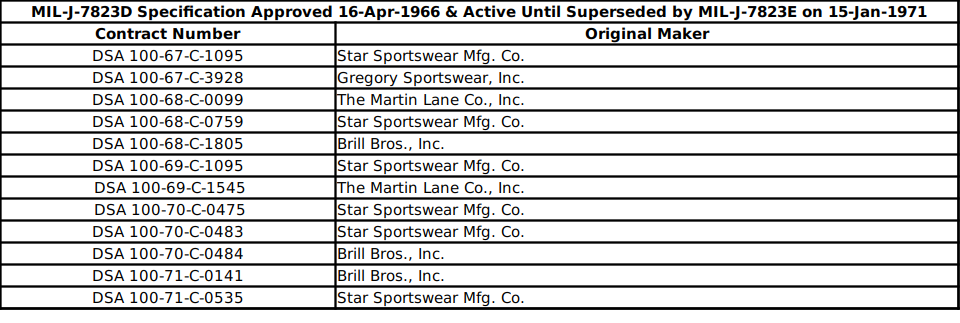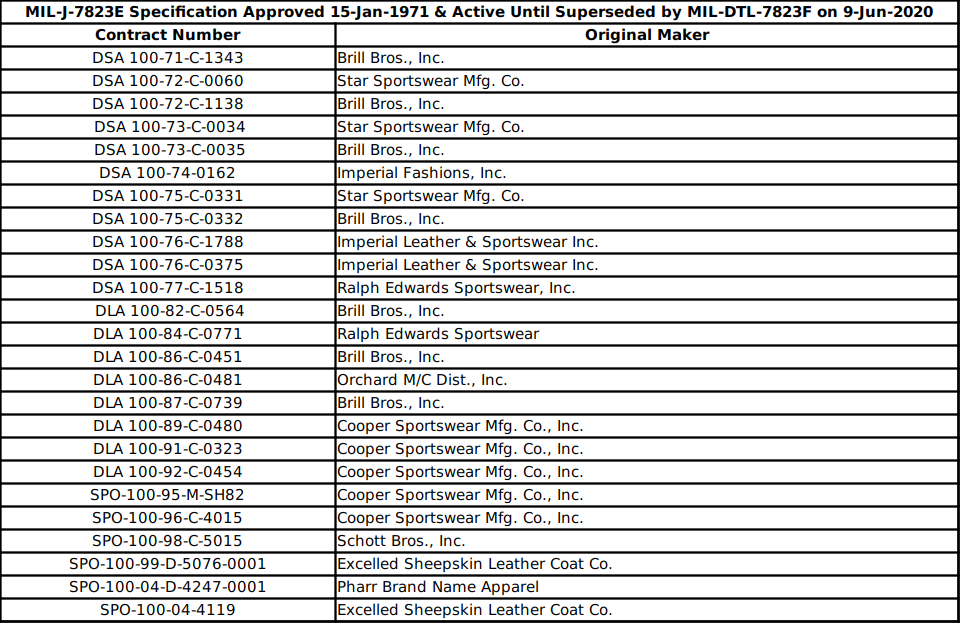-
When you click on links to various merchants on this site and make a purchase, this can result in this site earning a commission. Affiliate programs and affiliations include, but are not limited to, the eBay Partner Network.
You are using an out of date browser. It may not display this or other websites correctly.
You should upgrade or use an alternative browser.
You should upgrade or use an alternative browser.
“A Better Fighting Garment…” 3.0 - The Guide to U.S. Navy Intermediate Leather Flight Jackets
- Thread starter mulceber
- Start date
- Status
- Not open for further replies.
mulceber
Moderator
7823B Ex. No. 2 - Irvin B. Foster - photos courtesy of John Chapman. Note the zipper based of the zipper, which is not flush with the hem of the jacket.










mulceber
Moderator
MIL-J-7823C [3-Sept-1963]
The MIL-DIL-7823C Specification superseded MIL-J-7823B on 3-Sept-1963.
As Moore notes, “[t]hese are often considered by collectors to be the last of the ‘good’ jackets as they are the last [specification] to universally have the mouton collar…”, goatskin, and single-ply rib-racked knits. The easiest way to identify between a 7823B and a 7823C specification is the zipper. From the 7823C specification onwards the ‘paperclip’ no.10 zippers were ordinary brass, as opposed to the blackened metal that had preceded this specification.
mulceber
Moderator
In the contract number "DSA" refers to the "Defense Supply Agency", "1" and later “100" is a classification code related to clothing in this case, and the two digits near the end are the year, such as "64" for 1964. Nylon thread is used for the jacket and polypropylene thread for the buttons

Last edited:
mulceber
Moderator
mulceber
Moderator
mulceber
Moderator
mulceber
Moderator
MIL-J-7823D [16-Apr-1966]
The MIL-DIL-7823D Specification superseded MIL-J-7823C on 16-Apr-1966 and was never amended. On the label it states WEP or WP for Weapons (BuWeps = Bureau of Weapons).
These contracts used both Conmar and Scovill zippers and only A-2 folded-style waistbands. And they were the first to allow either real (MIL-M-5631) or synthetic (MIL-M-6590) mouton for the collar. In the contract number "DSA" refers to the "Defense Supply Agency", "100" is a classification code related to clothing in this case, and the next two digits are the date, such as "67" for 1967.
mulceber
Moderator
In the contract number "DSA" refers to the "Defense Supply Agency", “100" is a classification code related to clothing in this case, and the two digits near the end are the year, such as "67" for 1967. Nylon thread is used for the jacket and polypropylene thread for the buttons. The peak of 2,559 Naval Aviators across the Navy, Marines and Coast Guard occurred in 1969 during the Vietnam War.

mulceber
Moderator
7823D Ex. No. 1 - Gregory Sportswear - photos courtesy of @Jorgeenriqueaguilera - note that these jackets tend to run small and long in the torso:










mulceber
Moderator
7823D Ex. No. 2 - The Martin Lane Co. - photos courtesy of @Lord Flashheart - note the double-ply simple knits:







mulceber
Moderator
mulceber
Moderator
7823D Ex. No. 4 - Star Sportswear - photos courtesy of @Jorgeenriqueaguilera - note the dusty color of the used synthetic collar









mulceber
Moderator
MIL-J-7823E [15-Jan-1971]
The MIL-DIL-7823E Specification superseded MIL-J-7823D on 15-Jan-1971. On the label it states AS for Air Systems (NAVAIR = Naval Air Systems Command). Three amendments are known, with the second occurring on 24-Jun-1976. The third Amendment was implemented on 18-Oct-1984 and is the first MIL-J-7823 jacket permitting the use of cowhide (note the Amendment 2 and Amendment 3 dates in the top right corner).
The feature that most distinguishes them is the white spec label that made its first appearance here, although the first two contracts still featured a black spec label. These are the most abundant but the least collectible of all G-1 types. Most find that the cowhide creaks and the Dynel collars do not age as well as mouton; mouton tends to go from brown to golden with wear and exposure to the elements, whereas Dynel goes from black to a clumpy ‘dirty grey.’ E series jackets are, nonetheless, genuine USN flight jackets and they make for incredibly durable, “where-anywhere, do-anything”, daily beaters.
mulceber
Moderator
In the contract number "DSA" refers to the "Defense Supply Agency", "100" is a classification code related to clothing in this case, and the next two digits are the year, such as "71" for 1971. The DSA later becomes the “DLA” for “Defense Logistic Agency”, then “SPO” for “System Program Offices”. Nylon thread is used for the jacket and cotton thread for the buttons.

mulceber
Moderator
7823E Ex. No. 1 - Ralph Edwards Sportswear - photos courtesy of @Jorgeenriqueaguilera - note the white spec. label. These first appear early in the 7823E series:









mulceber
Moderator
7823E Ex. No. 2 - Orchard M/C Dist. Inc. - photos courtesy of OLX - note the faux goatskin texture of the cowhide:








mulceber
Moderator
MIL-DIL-7823F
The MIL-DIL-7823F Specification superseded MIL-J-7823E on 9-Jun-2020 and is the current version. Many of the changes were to reference the new specification nomenclature. Goatskin continues to be permitted, but cowhide is still used, although the Navy shows a preference for the original goatskin appearance as noted in this specification update “3.4.1.1 ... cattle hide leather shall have a goatskin grain finish.” Nylon thread is used for the jacket and cotton thread for the buttons. Perhaps a VLJ member can upload an example.
mulceber
Moderator
A FEW CONCLUDING THOUGHTS:
In the preface we noted "there is no reliable reference work on the 85-year history of what we now call the G-1 jacket" and that is the key takeaway. When researching US Navy jackets we found much of what we have heard was unsubstantiated. To be fair to Aota-san, in his book Full Gear he used the words "probably" and "guess" frequently when trying to fill in the gaps, but instead of being taken as the intended speculation, his words were repeated as Gospel. Much has simply been parroted over and over and is now taken as fact when it is not. Going through a trove of original documents has been a real eye-opener.For the military it doesn't need to look pretty, but it does have to work. And going through all the specifications it's clear how the USN constantly improves its quality control (QC) over time. It's a big shift from the 37J1 "two pockets will be provided" to the MIL-DTL-7823F going into much detail on how to fold and stitch particular areas. We also see the Navy going from no support specifications for ensuring quality control to almost two pages of them. And if you want to really understand today's MIL-DTL-7823F jacket specification you need to read and understand all the supporting specifications too. Contrast that to the one page AN6552 drawing. This QC is even more critical today, for we saw a government ad in a 1998 Commerce Business Daily for a MIL-J-7823E contract where "[a]ll materials to be used in the manufacture of these items will be contractor furnished." Quite a change from the ration days of WWII when most, if not all, materials were provided with the government responsible for QC.
mulceber
Moderator
Appendix A: NATO Stock Numbers
Every G-1 jacket post-NATO has what is called a NATO stock number. All that a NATO stock number does is allow the reader to know exactly what item they have. The NATO stock number for the G-1 Jacket (of all variations) [and post NATO] is either 8415-268-XXXX (older) or 8415-00-268-XXXX (newer). This is a minute detail which even high-end reproduction manufacturers such as the Real McCoys or Eastman Leather Company get wrong.The first 4 digits denote the general class of item, the 2 digits following that denote the country, the following 3 digits denote the item itself, and the final 4 digits denote the item to its corresponding size.
Take for example the code: 8415-00-268-7797 or (the older variation) 8415-268-7797.
8415: means Clothing, special purpose (as opposed to Clothing, general purpose [8405])
00: is the country code for the USA (UK is 99)
268: is the specific code for G-1 jackets
7797: means a G-1 in the corresponding size of 36.
For G-1s, the final 4 digits increase by 1 for every size up and decrease by 1 for every size down.
So, for example:
A G-1 in size 36 will have a NATO code of: either 8415-268-7797 or 8415-00-268-7797
A G-1 in size 38 will have a NATO code of: either 8415-268-7798 or 8415-00-268-7798
A G-1 in size 40 will have a NATO code of: either 8415-268-7799 or 8415-00-268-7799
A G-1 in size 42 will have a NATO code of: either 8415-268-7800 or 8415-00-268-7800
A G-1 in size 44 will have a NATO code of: either 8415-268-7801 or 8415-00-268-7801
A G-1 in size 46 will have a NATO code of: either 8415-268-7802 or 8415-00-268-7802
The point is that in most commercial jackets or even high-end reproductions like Eastman Leather Company (Elite Units VF-143 Pukin Dogs 7823D (WP) G-1 Jacket) or the Real McCoy’s 7823C (WEP) “Steve McQueen Jacket” do not account for the change in the last 4 digits as they correspond to size. For example, an Eastman Elite Units VF-143 Pukin Dogs 7823D (WP) G-1’s label will always say 8415-268-7800 regardless of changes in size. Thus, indicating that Eastman copied the jacket from a size 42 7823D (WP) G-1 jacket.
- Status
- Not open for further replies.
